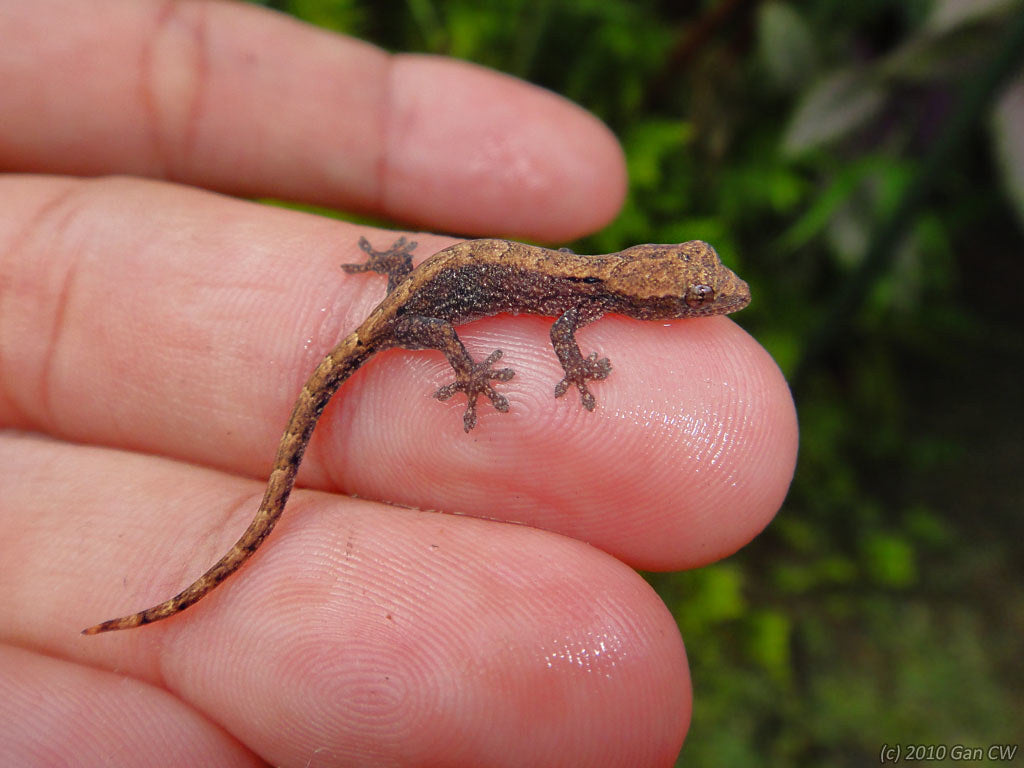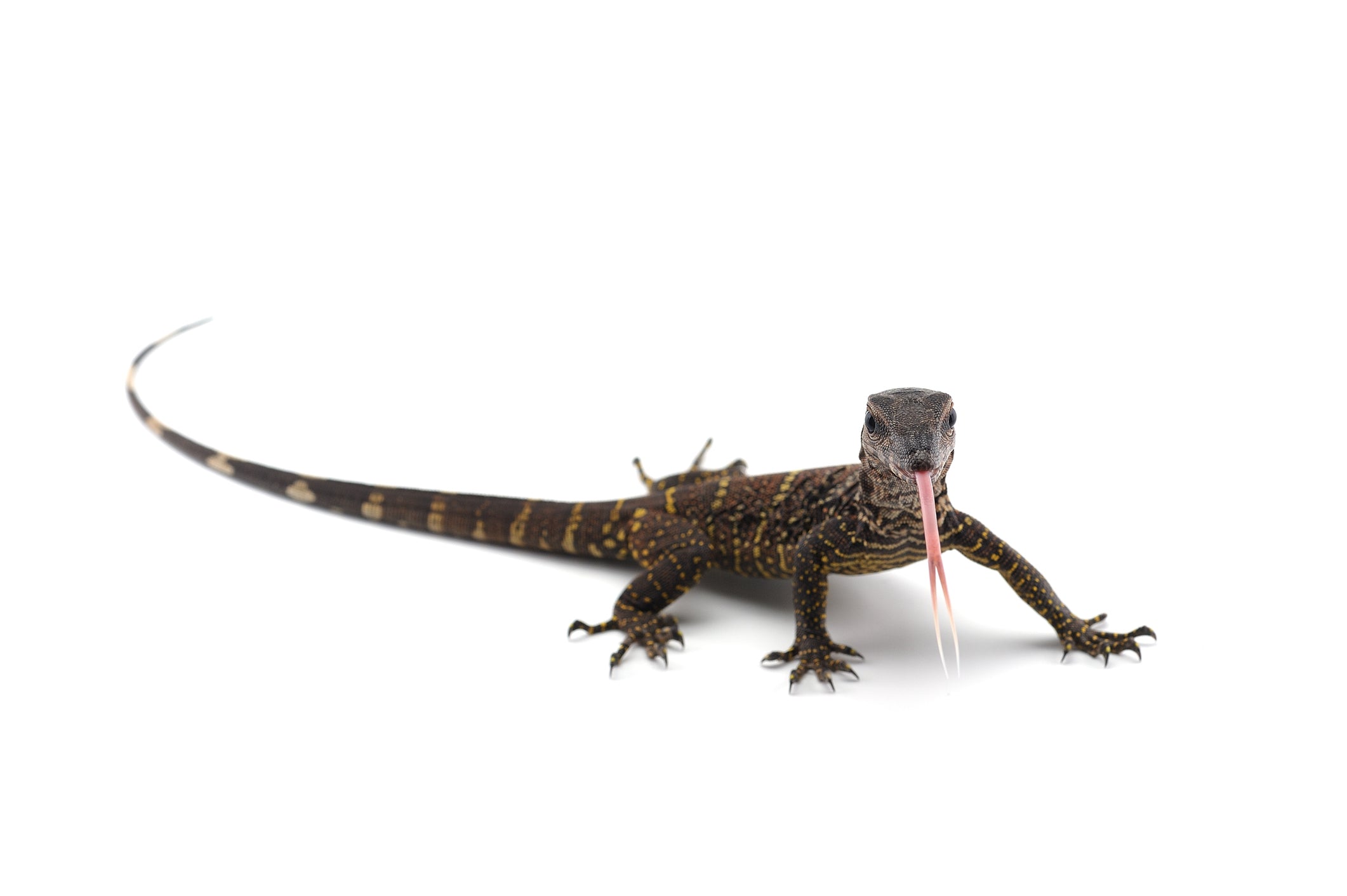Giant day geckos (Phelsuma grandis, formerly Phelsuma madagascariensis) are the largest geckos of the genus Phelsuma, a group of diurnal, arboreal lizards commonly called “day geckos”. They are native to the tropical rainforests of Madagascar, but have established invasive populations in areas such as Florida and Hawaii.
Giant day geckos have an elongated yet plump body with a thick tail, tapered snout, round lidless eyes, and sticky toe pads. They can grow as large as 12”. Their soft, velvety skin is generally bright green with a few bright red spots on their heads, although captive breeding has produced a variety of other colors and patterns.
Due to their delicate skin, need for a large enclosure and specialized equipment, giant day geckos are an intermediate-level pet reptile. With good care, they can live as long as 20 years.
How much space do giant day geckos need?
Giant day geckos are active, arboreal lizards who need plenty of space for running around and climbing. A single giant day gecko should be housed in absolutely no smaller than a 18” x 18” x 36” terrarium, although 24” x 24” x 36” is arguably a better minimum. Of course, larger is always better!
Cohabitation (keeping multiple giant day geckos together) is not recommended, and may result in fighting and injuries if attempted.
Do giant day geckos need UVB?
Yes!
Giant day geckos need medium-strength UVB as part of their enclosure. The best UVB bulbs for giant day geckos housed in a 36” tall terrarium are:
- Zoo Med T8 Reptisun 10.0, 24” — 4” above basking branch
- Arcadia ShadeDweller Kit — 6” above basking branch
- Arcadia T5 HO 6%, 22” — 8” above basking branch
The UVB bulb should be housed in a reflective fixture and placed close to the heat lamp. UVB is blocked by glass and plastic, so you can’t give your gecko UVB by placing its terrarium in front of an open window. Also make sure that the fixture your UVB bulb is in does not have a clear plastic bulb cover.
As day-active lizards, day geckos also benefit from a 6500K LED or T5 HO fluorescent grow light to provide extra bright light in the enclosure and better simulate the effects of the sun. These geckos are sun-lovers, and providing extra light is one of the best ways to enhance their color and general health.
Lights should be on for 11 hours/day during winter and 13 hours/day during summer to simulate seasonal changes in day length. This helps regulate hormonal cycles and may improve long-term health.
What basking temperatures do giant day geckos need?
Giant day geckos should have a basking surface temperature of 95°F, as measured by a digital probe thermometer with the probe zip-tied to the basking surface. The general temperature in the rest of the enclosure should be maintained between 80-88°F. Nighttime temps should not drop below 72°F.
Provide heat for your gecko by imitating the sun with a halogen heat lamp placed on one side of the enclosure. Do not use red bulbs, or blue bulbs, as these are not as effective. The basking surface should be a sturdy branch placed 4-8” below the heat lamp, depending on which UVB bulb you’re using.
The heat lamp should be turned off at night. If you need nighttime heating, use a lightless heat source such as a ceramic heat emitter connected to a thermostat.
What humidity levels do giant day geckos need?
Giant day geckos need a moderately high humidity environment for best health. Average humidity should be 50-70%, as measured by a digital probe hygrometer with the probe in the middle of the terrarium.
Misting your gecko’s enclosure with a sprayer first thing in the morning and again at night will help create the right humidity levels. It also provides an important source of drinking water! If you need help maintaining humidity, using a cool mist humidifier connected to a humidistat at night can help.
What substrate is good for giant day geckos?
Substrate covers the floor of your gecko’s terrarium and helps make the enclosure more attractive, but it also helps maintain humidity. It’s ideal to use a substrate that imitates the “substrate” that the reptile naturally lives on in the wild. For day geckos, that means it should resemble tropical soil. It should have small particles and hold moisture well.
We recommend the following substrates for giant day geckos:
Layering clean, chemical-free leaf litter on top of the substrate can also help with humidity.
Substrate should be at least 2” deep and completely replaced every 3-4 months. Remove poop and urates daily, along with contaminated substrate.
What décor can you use in a giant day gecko terrarium?
It’s terribly boring for a gecko to be stuck in an enclosure with nothing in it except substrate and food/water bowls. It doesn’t matter how big the enclosure is if you don’t put things in it for your pet to use and interact with. Day geckos tend to appreciate a fairly densely planted enclosure with either live or artificial plants, which can make their terrarium a great piece of home décor!
At bare minimum, you will need a branch for your day gecko to bask on and some live or artificial foliage for it to hide in. However, it’s best to include other items, such as:
- branches
- vines
- ledges
- live or artificial plants
Day geckos seem to do particularly well when live plants are used as part of their enclosure.
What do giant day geckos eat?
Day geckos are omnivorous, which means that they need to eat a balanced diet of plant and animal matter in order to get the nutrition that their bodies need. In the wild, they primarily eat insects and fruit. In captivity, it’s best to feed them primarily live insects, supplemented with high-quality, specially-formulated crested gecko diet (CGD).
How often giant day geckos need to eat depends on age:
- Hatchlings and Juveniles (0-12 months) — insects daily, CGD 2x/week
- Adults (>12 months) — insects 2x/week, CGD 1x/week
One serving of insects is 3-5 insects slightly smaller than the gecko’s head. CGD should be served in condiment/gecko cups via wall-mounted feeder.
Feeder insects for day geckos: dubia roaches, discoid roaches, red runner roaches, crickets, hornworms, silkworms
Best crested gecko diets: Pangea, Repashy, Leapin’ Leachie, Zoo Med, Lugarti, Black Panther Zoological, Gecko Pro
Remember, the key to great nutrition is variety!
Supplements
Although crested gecko diet doubles as a vitamin supplement, you will need calcium powder to dust on feeder insects. We recommend Repashy Supercal NoD.
Water
Although your gecko will get most of its drinking water from daily mistings, it’s a good idea to also provide a wall-mounted water dish. Change the water daily and scrub the bowl with a reptile-safe disinfectant weekly, or whenever it becomes soiled.
Do giant day geckos like to be handled?
Few reptiles actually “like” to be held, and giant day geckos aren’t one of them. Instead of interacting with your gecko by holding it, try hand-feeding it instead with a pair of feeding tweezers.
If you have to grab your gecko for some reason, be VERY gentle — they’re quite delicate, and may slough their skin and/or drop their tail in the attempt to escape!
*This care sheet contains only very basic information. Although it’s a good introduction, please do further research with high-quality sources to obtain additional information on caring for this species.




Leave a comment
This site is protected by hCaptcha and the hCaptcha Privacy Policy and Terms of Service apply.